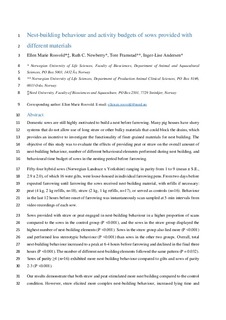| dc.contributor.author | Rosvold, Ellen Marie | |
| dc.contributor.author | Newberry, Ruth C. | |
| dc.contributor.author | Framstad, Tore | |
| dc.contributor.author | Andersen, Inger Lise | |
| dc.date.accessioned | 2018-05-29T12:30:51Z | |
| dc.date.available | 2018-05-29T12:30:51Z | |
| dc.date.created | 2018-01-24T15:07:42Z | |
| dc.date.issued | 2017 | |
| dc.identifier.citation | Rosvold, E. M., Newberry, R. C., Framstad, T. & Andersen, I. L. (2017). Nest-building behaviour and activity budgets of sows provided with different materials. Applied Animal Behaviour Science, 200, 36-44. doi: | nb_NO |
| dc.identifier.issn | 0168-1591 | |
| dc.identifier.uri | http://hdl.handle.net/11250/2499622 | |
| dc.description | Author's accepted version (post-print). | nb_NO |
| dc.description | Available from 09/12/2018. | |
| dc.description.abstract | Domestic sows are still highly motivated to build a nest before farrowing. Many pig houses have slurry systems that do not allow use of long straw or other bulky materials that could block the drains, which provides an incentive to investigate the functionality of finer-grained materials for nest building. The objective of this study was to evaluate the effects of providing peat or straw on the overall amount of nest-building behaviour, number of different behavioural elements performed during nest building, and behavioural time budget of sows in the nesting period before farrowing.
Fifty-four hybrid sows (Norwegian Landrace x Yorkshire) ranging in parity from 1 to 9 (mean ± S.E., 2.9 ± 2.0), of which 16 were gilts, were loose-housed in individual farrowing pens. From two days before expected farrowing until farrowing the sows received nest-building material, with refills if necessary: peat (4 kg, 2 kg refills, n = 18), straw (2 kg, 1 kg refills, n = 17), or served as controls (n = 16). Behaviour in the last 12 h before onset of farrowing was instantaneously scan sampled at 5-min intervals from video recordings of each sow.
Sows provided with straw or peat engaged in nest-building behaviour in a higher proportion of scans compared to the sows in the control group (P < 0.001), and the sows in the straw group displayed the highest number of nest-building elements (P < 0.001). Sows in the straw group also lied more (P < 0.001) and performed less stereotypic behaviour (P < 0.001) than sows in the other two groups. Overall, total nest-building behaviour increased to a peak at 6–4 h before farrowing and declined in the final three hours (P < 0.001). The number of different nest-building elements followed the same pattern (P = 0.032). Sows of parity ≥4 (n = 16) exhibited more nest-building behaviour compared to gilts and sows of parity 2–3 (P < 0.001).
Our results demonstrate that both straw and peat stimulated more nest building compared to the control condition. However, straw elicited more complex nest-building behaviour, increased lying time and reduced time spent on stereotypies in the 12 h before farrowing, suggesting that straw has a better function as nest-building material than peat. | nb_NO |
| dc.language.iso | eng | nb_NO |
| dc.publisher | Elsevier | nb_NO |
| dc.rights | Attribution-NonCommercial-NoDerivatives 4.0 Internasjonal | * |
| dc.rights.uri | http://creativecommons.org/licenses/by-nc-nd/4.0/deed.no | * |
| dc.subject | Ethology | nb_NO |
| dc.subject | Animal welfare | nb_NO |
| dc.subject | Animal husbandry | nb_NO |
| dc.title | Nest-building behaviour and activity budgets of sows provided with different materials | nb_NO |
| dc.type | Journal article | nb_NO |
| dc.type | Peer reviewed | nb_NO |
| dc.description.version | acceptedVersion | nb_NO |
| dc.subject.nsi | VDP::Matematikk og Naturvitenskap: 400::Zoologiske og botaniske fag: 480 | nb_NO |
| dc.source.pagenumber | 36-44 | nb_NO |
| dc.source.volume | 200 | nb_NO |
| dc.source.journal | Applied Animal Behaviour Science | nb_NO |
| dc.identifier.doi | 10.1016/j.applanim.2017.12.003 | |
| dc.identifier.cristin | 1551138 | |
| dc.relation.project | Norges forskningsråd: 207804 | nb_NO |

